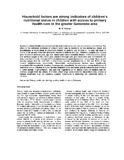Household factors are strong indicators of children’s nutritional status in children with access to primary health care in the greater Gaborone area

View/
Date
2007-02Author
Nnyepi, M.S.
Publisher
Academic Journals. http://www.academicjournals.orgType
Published ArticleMetadata
Show full item recordAbstract
Access to primary health care can improve the nutritional status and survival of preschool children. The effect of the universal provision of primary health care in Botswana on the prevalence, types, and determinants of malnutrition in preschool children is unclear. 522 children 0 - 5 years old from 12 clinics in the greater Gaborone area were studied to address this gap. Children’s weights and heights were measured. Birth weights, age, sex, household’s socio-economic factors, children’s illness status and services sought at the clinics were obtained through care giver interviews and confirmed by the data in the health cards. 11.3 and 13.7% of children were stunted and wasted, respectively. Stunting and wasting ranged from 9.1 and 3.6% in middle-high income neighborhoods to 18.2 and 20.8% in low income neighborhoods, respectively. Households’ socio-economic factors were significantly associated with households’ location. Consequently, households’ location was a strong determinant of nutritional status. Children in higher income neighborhoods had better growth indicators than children in lower income neighborhoods. This was true regardless of the illness status of children and the services sought from the clinics. Therefore, where large socio-economic disparities exist, access to primary healthcare may not equitably support households in improving the nutritional status of children.
